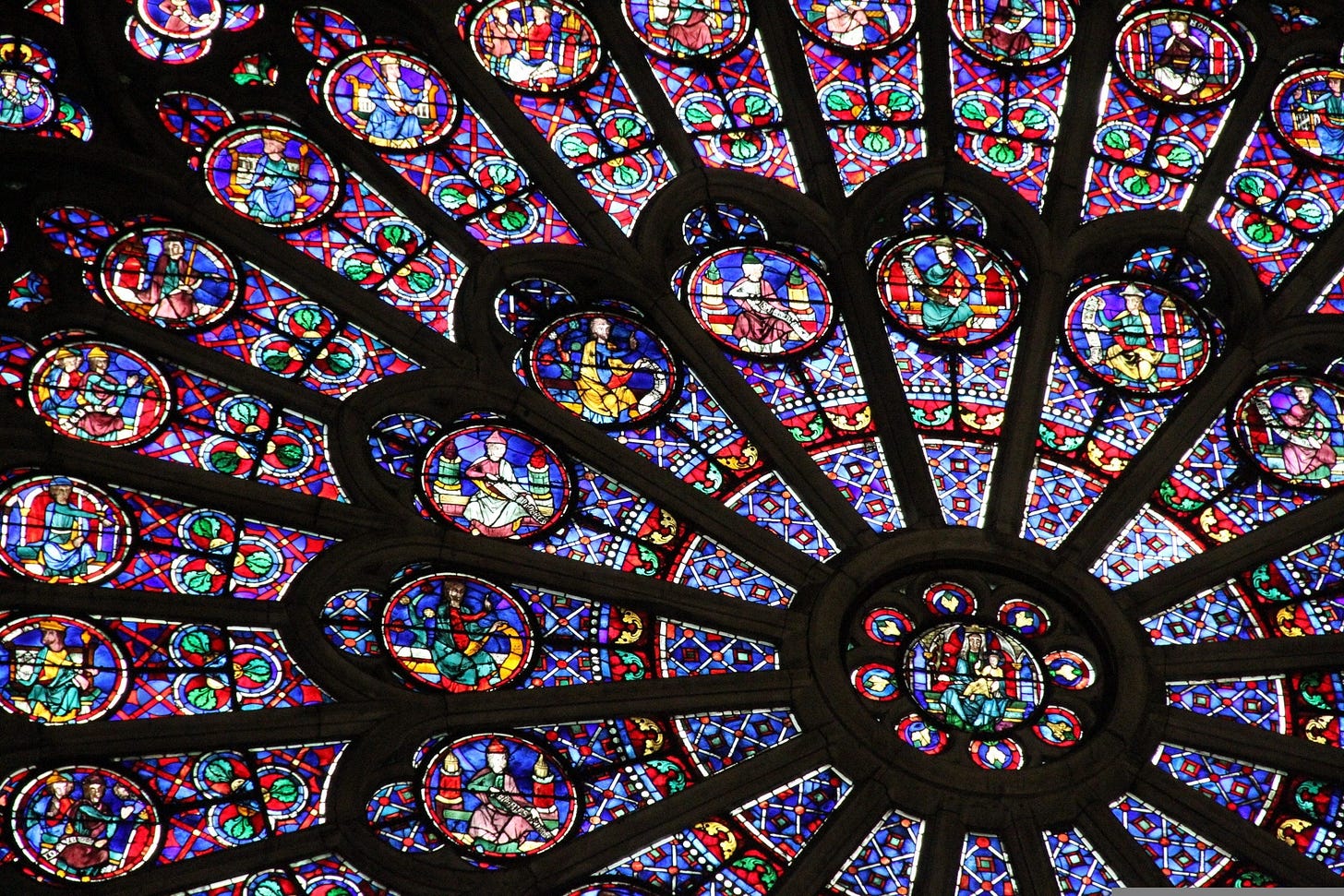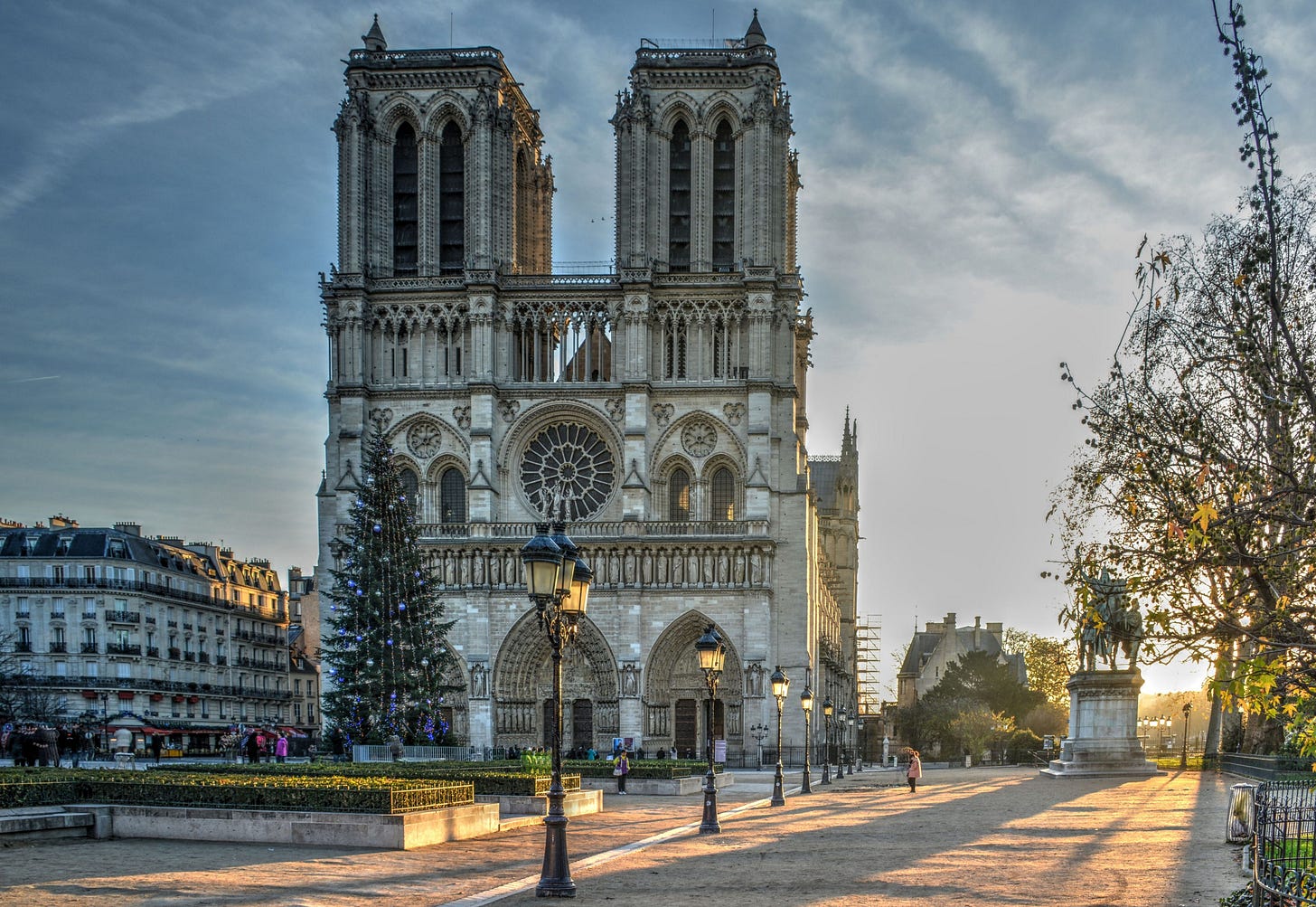The Great Work, the Minor Work, and the Inner Work.
Is Software Development like a Cathedral? Or How do we become Enlightened?
I was in the Great Redwood Forest, at dweb, listening to and participating in a discussion on the "Great Work" and its relationship to Silicon Valley.
What is the Great Work? I first thought about the great American novel or some great invention, and I was not so far off. The Great Work is some hugely ambitious project that inspires people to come from far and wide and lend their expertise to realizing it. The great Cathedrals of the Middle Ages are an example.

The Great Work of Computation
The mathematician and author Rudy Rucker connects the Great Work with Silicon Valley. He likens Silicon Valley to a grand medieval center where we are building a cathedral — the Great Work. Craftspeople of all types descend upon the center to contribute to this "Great Work." But what is the Great Work? Maybe AI, Rucker posits. I call this great work "Computation."
The Great Work in History
The Great Work is also an ancient alchemical term that refers to the creation of the Philosopher's Stone. Alchemists spent their lives attempting to create this Great Work — which turns lead into gold or grants eternal life. Psychologist Carl Jung interprets alchemy and the Philosopher's Stone as self-transformation. The Philosopher's Stone does not turn actual lead into gold but turns a person's consciousness from the lead to the gold.
Awake!
Jung calls this process individuation. Just as a seed creates a flower in the right conditions, a human may transform and express her uniqueness. We may break out of our societal conditioning and act freely. Nietzsche called this the transvaluation of values — to be modern is to decide for ourselves what is right rather than mindlessly following family, tradition, or custom. Individuation is the Great Work of the Alchemists, and it is alive in many traditions such as Moksha, interbeing, merging with the godhead, awakening, and self-actualization: the inner work.
The Cathedral as the Great Work

Rucker uses the Cathedral as an example of the "Great Work," and expert craftspeople come from all around to participate in creating this work. Craft work and inner work go together in many traditions; many contemporary books, like Zen and the Art of Motorcycle Maintenance and Shopcraft as Soulcraft, also point to this. As we sharpen our craft, we also sharpen something profound inside ourselves.
As a software developer, I have always felt like a craftsperson—and that this feeling is unique in 21st-century Western society. I have always felt that software development is soul development, especially as my colleagues and I, during the first dot-com boom, traded recordings on Alan Watts, the Firesign Theater, and Robert Anton Wilson.
Above is a beautiful medieval stained glass window, but we lost this knowledge over time. Schwaller de Lubicz, a 19th-century Egyptologist, chemist, and mystic, was able to recreate this glass by using chemistry and alchemy, or so the story goes. Alchemy, craft, inner work, and outer work materially combine to create the Great Work.
Even Rucker points to this feeling of self-determination as a part of the "Great Work" of computation.
The reality is that there is no unifying Great Work, there are just a lot of people here in the pit together, slamming and hacking. Our Great Work is to stay in the pit, to control our own destinies, and to hack what we can of the world.
"Control our destinies" sounds like self-actualization. But Rucker also says there is no Great Work, so what is everyone working on?
The Minor Work
Deleuze and Guattari (D&G), the 20th-century philosophers/psychoanalysts, introduced the concept of the machine to the realm of desires and drives — and from there to social and political relations and the formation of the individual. Two of their ideas stand out in our discussion of the "Great Work" of computation:Minor Literature and Deterritorialization.
D&G introduces minor literature in analyzing Kafka's writing, which has been adopted by other creative modes—like cinema. Originally defined as "A minor literature is not the literature of a minor language, but the literature a minority makes in a major language" (Deleuze), minor literature has expanded to include any literature produced outside the hegemonic structure of its culture. From this location, minor literature can be radical, challenging established norms of culture, politics, and language.
The people slamming and hacking, the proliferation of APIs, UNIX tools, apps, and frameworks are all minor tools. They are all produced in a foreign language — most programming languages may use English words, but they are not in the English language. I want to acknowledge the corpus of esoteric languages and languages written with words in other vernaculars. But no one's first language is a computer language. All software is, by definition, a minor literature.
Can minor literature be a Great Work — a hegemonic structure? If it can, it will undoubtedly look different than the Cathedral.
The Detertorrialized Work
The second concept, deterritorialization, was initially used to describe how we can separate social relations from their original context and move them into various new contexts to create new meanings. I think of the same social relations on LinkedIn vs. Match vs. Facebook vs. Signal and how these different contexts change my deterritorialized relations. In a larger perspective, deterritorialization lets us strip away words, signs, and symbols from their original context, make them all ontological equals, and then recombine them in new ways — like a database or a graph.
Computation is what makes deterroritalization possible on a grand scale. The Great Work of Computation is deterritorialization.
Seek Ye the Gnarl
This piece began with the idea that Silicon Valley was the location of the Great Work, but deterritorialization is about moving beyond physical boundaries. Have we just yet to find the boundary, or does the Great Deterritorialized Minor Work not exist in a physical location?
In Seek Ye the Gnarl, Rudy Rucker talks about how the edges are where exciting things happen — he calls this the Gnarl. In his Medium article, he writes about co-editing "MONDO 2000 USER'S GUIDE TO THE NEW EDGE."
Now what exactly IS this Great Work which is taking place on the New Edge? The Great Work is like a Mandelbrot Set of which we are the pixels, or even the steps of the computation. The Great Work is like a living body in which you and I are like a cell, or even like a specific chemical process, like an enzyme which copies ten thousand rungs of DNA. The Great Work is so big that nobody alive can even put a name on it…
The Great Work is so large that we cannot perceive it—it is a hyperobject, a living object, or a dynamic object. It is itself deterritorialization, constantly stripping itself away from the meanings it is embedded within.
The Great Work on the Edge
How can we think about spaces and edges, and how is this related to treating a Great Work that has both a space and an edge? ThCathedralal, after all, is the creation of a space.
In Folds, another book by Deleuze, he links Leibnitz, his invention of calculus, and his metaphysical notion of monads to the aesthetics of Baroque art and architecture- i.e., the Baroque Cathedral.
Deleuze analyzes the folds of Baroque churches as both solid and immaterial; they are dark yet illuminated. Deleuze posits that calculus made these structures possible by measuring curves and the spaces of curved objects.
The approach of post-phenomenologists is that tools create worlds that allow the creation of Great Works. With a new world comes a new edge. The edge that Rucker talks about is another new world brought into being by new computational tools.
Fractal Spaces
Deleuze’s fold reminds me of the plant St John's Wort, Hypericum perforatum. St John's Wort petals appear solid but consist of tiny pinholes—hence the name perforatum. It's hard to find a photo of these pinholes, and the plants no longer flower this late in the season where I live. They flower in midsummer, near the feast of St John the Baptist—hence the name St John.
Minor Works are like the folds or holes of St. John's Wort, a fractal, a Mandelbrot set: a space with infinite circumference but finite area or a space that is infinitely empty with a finite circumference.
Tools and Worlding
Calculus was not the Great Work; thCathedralal was. But it was a tool that created the space, or the world, where a Baroque Cathedral could be built. It was a psychotechnlogy.
John Vervaeke defines psychotechnologies as "a socially-generated and standardized way of formatting, manipulating, and enhancing information processing that's readily internalizable into human cognition." (Ep 42 from the Awakening from the Meaning Crisis — Intelligence, Rationality, and Wisdom [56:53]
— 42, if you remember, is also the answer to life the universe and everything.)
Pyschotechnologies provide a cognitive leap that makes a Great Work possible. What is a Great Work? It is the pinnacle of a cognitive leap, where craftspeople sharing the same epistemological perspective come together to create.
What is the psychotechnology of computation? I have a few ideas, but we are not all clear yet. Getting clear on this is the work of the edges. At some point, the space will fill out, concepts will be reterritorialized, and we will build a Great Minor Deterritorialized-Reterritorialized Work.
For me, the more important question is whether or not this outer work of crafting the Computational Great Work will also lead to the inner transformation of turning lead into gold. What is the point of having a Great Work if we are not free to enjoy it?




